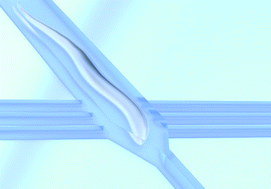A microfluidic device for whole-animal drug screening using electrophysiological measures in the nematode C. elegans†‡
Abstract
This paper describes the fabrication and use of a microfluidic device for performing whole-animal chemical screens using non-invasive electrophysiological readouts of neuromuscular function in the nematode worm, C. elegans. The device consists of an array of microchannels to which electrodes are attached to form recording modules capable of detecting the electrical activity of the pharynx, a heart-like neuromuscular organ involved in feeding. The array is coupled to a tree-like arrangement of distribution channels that automatically delivers one nematode to each recording module. The same channels are then used to perfuse the recording modules with test solutions while recording the electropharyngeogram (EPG) from each worm with sufficient sensitivity to detect each pharyngeal contraction. The device accurately reported the acute effects of known anthelmintics (anti-nematode

- This article is part of the themed collection: Focus on USA

 Please wait while we load your content...
Please wait while we load your content...